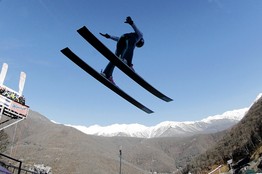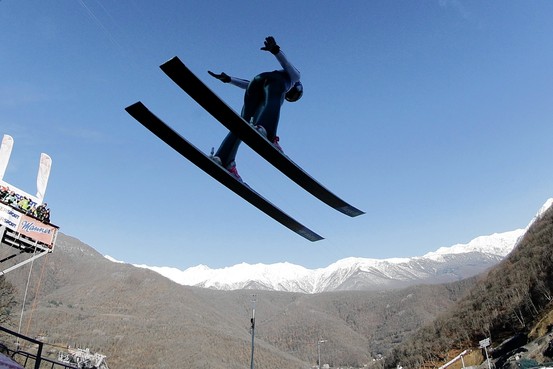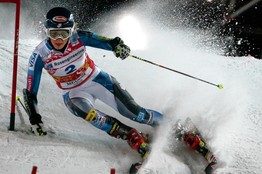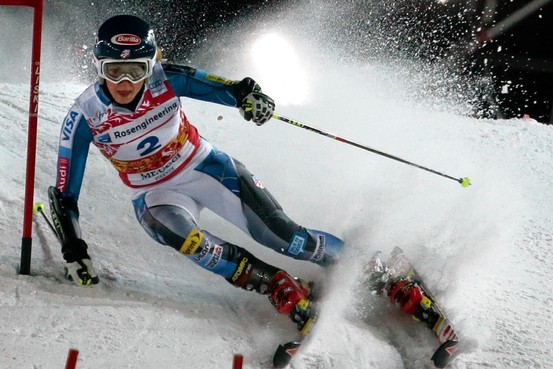Science, the Human Body and Skiing
08 Feb 2013, Posted by in Latest News- Updated February 8, 2013, 12:10 p.m. ET
Betting Big on Nitrogen
U.S. Ski Team Pins Hopes for Sochi on Science
By MATTHEW FUTTERMAN
![[image]](https://www.skinastc.com/wp-content/uploads/2013/02/AR-AB424_SP_SOC_G_20130207180940.jpg) Reuters
Reuters
Ted Ligety, above, Sarah Hendrickson and Mikaela Shiffrin are strong medal contenders for the U.S. at the Sochi Games.
Park City, Utah
Most People who saw the footage of American all-everything skier Lindsey Vonn somersaulting over the snow on an Austrian mountain this week, shredding her knee ligaments and breaking her tibia in the process, figured they had just seen the end of the U.S. Olympic team’s chances at next year’s Winter Olympics in Sochi.
Put away the star-spangled cowbells. Leave Old Glory at the bottom of the mountain. Cue up your favorite recording of Mozart’s “Requiem.”
But here’s where the story takes an unexpected turn: Over the last six years, the U.S. Ski and Snowboard Association—the engine that increasingly drives the medal hopes for the entire U.S. Olympic team—has done something extraordinary. Instead of contenting itself with a couple of quirky stars who might get hot at the Olympics, the federation has invested serious money—at least $1 million a year—to build a deep bench.
U.S. alpine skiers have landed on the podium 27 times this season, including 16 wins. Utah’s Ted Ligety dominates giant slalom and on Wednesday, he won the super G world championship. Mikaela Shiffrin, just 17 years old, has already won three world cup slalom races. The U.S. has had three women not named “Vonn” ranked among the top six in downhill.
In cross country, Kikkan Randall has three wins, and is arguably the world’s top sprinter. American snowboarders and freestyle skiers continue to set the standard in numerous events. And 18-year-old Sarah Hendrickson looks like a lock to win the first Olympic women’s ski jump gold.
Given that these athletes will compete for about half of the total medals available in Sochi, it’s fair to say that this American power surge is the country’s best hope for sweeping the medal races in its second consecutive Olympics—and winning both the overall and gold-medal races at a Winter Olympics for the first time since 1932.
The architects of this skiing success are an unlikely duo of scientists: Troy Flanagan, who has a Ph.D. in aerospace engineering from Royal Melbourne Institute of Technology in Australia (a country where it barely snows) and his top lieutenant, Jim Stray-Gundersen, a former competitive cross-country skier who became a surgeon and later pursued post-doctoral fellowships in cardiology.
Together, these two men have spent six years conducting a $1 million-a-year science experiment, which makes skiers and snowboarders its laboratory subjects. To evaluate athletes, the USSA staff will hook them up to a system that pumps nitrogen and oxygen into their lungs on a treadmill. They’ll strap them to a carbon monoxide re-breathing test that measures how much hemoglobin they’re carrying in their blood. (Word on the street is that about 15 grams per kilogram almost guarantees a gold-medal performance). Alpine skiers are asked to strap on a black, pager-sized contraption that measures their speed and angular motion as they hurtle down the mountain.
“The idea is to change the nature of training from simply piling on more work to creating a system based on trial and error, of testing and adjusting, to find what makes that 1% difference,” says Flanagan.
This eccentric take on training is on display at the USSA’s Center for Excellence, down the road from the site of the 2002 Winter Olympics. One of the most striking sights at the center is the gigantic cross-country skiing treadmill that is connected, via rubber tubing, to two massive metal tanks that contain nitrogen and oxygen.
By adjusting the ratio of the gases athletes breathe while on the treadmill, USSA scientists can make a session that takes place at 6,000 feet feel like it’s happening at 2,000 feet, or 8,000 feet, or 4,900 feet—the elevation of the cross country competition in Sochi.
They also created something called a carbon monoxide re-breathing test, which they believe is the most effective way to measure how much hemoglobin an athlete is carrying. Hemoglobin is the key to being able to transport oxygen to muscles. Flanagan also did some of the early design work on the motion sensor for alpine skiers.
Athletes do triple jumps down a 10-meter lane lined with infrared sensors to determine their energy level before a workout. They jump on an electronic plate to measure whether their leg muscles are more catlike or powerful.
To design the suit gold medalist Billy Demong wore in Vancouver during Nordic Combined, which involves both ski jumping and cross-country, Flanagan and his team created a digital avatar of Demong’s body and used computer imaging to determine the most aerodynamic pattern for stitching the suit. Demong and the team then traveled to Australia to test the design in a tunnel against a 65-mile per hour gusts.
Alpine skiers attach infrared cameras to the edge of their skis to measure the degree of lateral slippage around a gate.
Part of the effort is to look for patterns—and relationships between things that may be hidden. USSA athletes are asked to record everything about their days: from their workout to how well they slept to whether they had the sniffles. Trainers armed with remote testing kits deliver updates to the database from across the globe.
In the same database, their performances are plotted on a career arc and measured against all other elite skiers. Athletes who drift too far outside the curve of a potential Olympic medal winner stand to lose financial support from the USSA.
“Our mission is to be the best in the world and we measure that by winning Olympic medals,” said Bill Marolt, since 1996 the chief executive of the USSA, whose athletes won 21 of 37 U.S. medals in Vancouver in 2010, compared with 10 of 25 in Torino in 2006.
Stray-Gundersen worked for the Norwegian Olympic Committee from 1997-2002, sealing bedrooms of the country’s top Nordic athletes and adjusting the oxygen and nitrogen content of the air, so they could sleep in a simulated high altitude environment (he was the scientist who developed the concept of living at high altitude to increase hemoglobin levels). Norway topped the gold medal table in 2002 with 13, and it wasn’t simply because kids there grow up on cross-country skis. It was “objective and close monitoring of training,” he says.
For athletes, working under this new regime can be a bit baffling. Moguls racer Heather McPhie was a little confused when Flanagan and her coaches told her she needed to build up her endurance. Her event lasts about 30 seconds. Flanagan and the USSA coaches put her on an exercise bike and told her to pedal at a conversational pace for hours. “It seemed like such a waste of time,” McPhie says.
They added circuit workouts—box jumps, wall sits, Romanian single leg dead lifts (think multiple knee bends while holding dumbbells), with 30 seconds between stations, and five minutes between circuits. McPhie dropped five pounds, lowered her body fat composition and won her first World Cup event in January 2010. She is now among the world’s top-ranked mogul skiers.
If all this science pays off, the U.S. might be able to sweep the gold and overall medal races in Sochi as it did in London—an unprecedented feat in consecutive games in the post-Soviet era. Without Vonn, who was a virtual lock for multiple medals, it’s a taller task.
After her crash at the world championships Tuesday, Vonn has been scheduled for major orthopedic surgery. As hard as she’ll try to rehab in time forSochi, ski racing at 80 miles per hour is hard enough with two healthy knees.
To complicate matters, Bode Miller, the best male American skier ever, is also out for the season with a knee injury.
Write to Matthew Futterman at matthew.futterman@wsj.com





